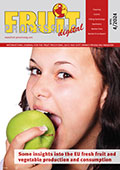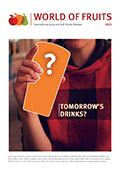New opportunities for product development
Personalised food, vegetable proteins with the bite of meat or production on demand; digitally controlled food production enables innovations which were inconceivable until very recently. From 29 June, businesses can address all their questions about digital technology to the Digital Food Processing Initiative (DFPI), a cooperative venture between Wageningen University & Research, TNO, AMSYSTEMS Center and Eindhoven University of Technology.
The launch of the Digital Food Processing Initiative will take place on 29 June during the 3D Food Printing Experience at the Wageningen campus. “We provide companies with insight into the possibilities and support them with knowledge about food and high-tech systems,” says Ben Langelaan, research manager Food Technology in Wageningen UR and member of the DFPI steering group. “This helps them more easily translate ideas to the market.”
The ambition of the DFPI is to be the global consortium for digitally controlled food production. “Our combined expertise of food and digital technology is unique, which is why we can really help companies move forward,” adds Pieter Debrauwer, research manager at TNO/AMSYSTEMS Center and member of the DFPI steering group. “Sometimes it may be necessary to change the recipe in order to create an attractive product, while at other times the equipment needs adapting in order to realise the right process conditions.”
More than 3D printing
DFPI focuses on five innovation themes: sustainability, personalised food, on-demand food production, new forms and flavours, and new social experiences. While the main food applications to date have been related to 3D printing – such as new shapes of pasta – both organisations expect digital techniques to have a much larger social impact.
On-demand production, for example, could lead to less food waste, while personalised food can help produce special high-protein products for the elderly or athletes. 3D printing can change the functionality of food via the development of new structures, textures and flavours, which could have potential for people who have difficulty swallowing. Digital techniques are expected to drastically change the production, location and logistics of food production.
Introduction
Food producers, ingredient suppliers, machinery manufacturers, caterers, retailers and other interested parties can have a first look on 29 June at the options for digital food processing. The introduction will include various demonstrations of 3D food printing and presentations on the successful application of digital techniques in the food industry. Professor Arthur Mol, Rector Magnificus and vice-president of the WUR Executive Board, will officially launch the DFPI at 11.30. More information about the programme and registration is available via www.wur.eu/3dfoodprinting.
For questions about partner projects, interested parties can contact program manager Joost Blankestijn at Wageningen Food & Biobased Research (joost.blankestijn@wur.nl) or Daniel van der Linden at TNO/AMSYSTEMS Center (daniel.vanderlinden@tno.nl).
Initiators
DFPI is a joint initiative of Wageningen Food & Biobased Research, the Wageningen chair groups Food Process Engineering and Physics and Physical Chemistry of Foods, and AMSYSTEMS Center, a partnership between TNO Equipment for Additive Manufacturing and TU Eindhoven High Tech Systems Center.
Orange production final1 estimate totals 398.35 million boxes
The 2017-2018 orange production final estimate for the São Paulo and West-Southwest of Minas Gerais Citrus Belt, published on April 10, 2018 by Fundecitrus – Fund for Citrus Protection, carried out in cooperation with Markestrat, FEA- RP/USP and FCAV/Unesp2 – is of 398.35 million boxes of 40.8 kg each, 62 % higher in comparison to that of the previous crop (2016-2017) with a final figure of 245.31 million boxes, and 25 % above the average of the seasons of the last ten years3. All crop estimate updates published along the season showed positive change as compared to the previous expectation. The final figure represents an increase of 0.27 % in relation to the update published in February 2018 and 9.30 % in relation to the initial May 2017 forecast.
The closing figure for total production includes:
- 77.48 million boxes of the Hamlin, Westin and Rubi varieties;
- 18.02 million boxes of the Valencia Americana, Valencia Argentina, Seleta and Pineapple varieties;
- 118.47 million boxes of the Pera Rio variety;
- 139.62 million boxes of the Valencia and Valencia Folha Murcha varieties;
- 44.76 million boxes of the Natal variety.
Approximately 30.51 million boxes of the final estimated crop were produced in the West of Minas Gerais.
Regarding the productivity index, the crop 2017-2018 showed a remarkable performance: 1,033 boxes were harvested per hectare, against 634 boxes per hectare in 2016-2017. The significant variation between the two crops was triggered by a favorable conjunction of factors. Suitable weather for citrus growing and improved cultural practices in groves in 2016, evidenced by the increased demand of inputs for crop nutritional and phytosanitary management, influenced positive results…
1 Hamlin, Westin, Rubi, Valencia Americana, Valencia Argentina, Seleta, Pineapple Pera Rio, Valencia, Valencia Folha Murcha and Natal.
2 Department of math and science.
Please download the complete forecast under: https://bit.ly/2JGhOMT
Turkey produced 4.3 million MT of citrus, including orange, lemon, mandarin, and grapefruit in MY 2016/17.
Turkey is the eighth ranked country in the world for citrus production with a 2.7 percent share. Citrus production in Turkey is 63 percent above the amount that is consumed domestically.
Turkish producers have started to search for new varieties from the other leading citrus producing countries in order to improve domestic production and capture new export markets.
Approximately half of the total citrus production is exported, with an export value of $880 million. Top export destinations are Russia and Iraq, followed by Ukraine.
Turkish citrus exporters would prefer more diversified export markets to avoid complications from any political tensions.
Please download the complete report under: gain.fas.usda.gov
Although production in the current crop (2017/18) has increased, orange prices in São Paulo kept at firm levels in 2017 in the industry and in natura segments, underpinned by higher demand from citrus processors.
An estimate released by Fundecitrus (Citrus Defense Fund) in December indicated that the 2017/18 production might total 385.2 million boxes, 57 % higher compared to the 2016/17 season (one of the smallest productions in all times) and possibly the highest supply since 2012/13. Therefore, based on the forecast for higher production, players from the industry expect crushing activities to be intense in early 2018. Since the beginning of activities in 2017, processors operated at a fast pace, at 100 % of the capacity in practically all units.
Higher production in the citrus belt also changed the purchasing scenario. Before sizing the production, major processors in São Paulo started to contract fruits in the last quarter of 2016, and trades amounted to 26.00 BRL per 40.8-kilo box, harvested and delivered, regardless of early, mid-season and late varieties.
These trades, however, were not observed again in 2017, because processors had comfortable inventories and limited new purchases in the spot market, as the volume was already contracted and there was no expectation for restrictions of raw material supply. Thus, values were around 18.00 BRL per box. In the partial of the season (from July to December), prices paid for pear oranges and late varieties in the sport market averaged 18.96 BRL per 40.8-kilo box, harvested and delivered at the factory, moving down 14.7 % compared to the average of the second semester in 2016.
Output was higher and was welcome to help reduce very low ending stocks in 2016/17. According to estimates from CitrusBR (Brazilian Association of Citrus Exporters), inventories of SP processors may recover by 93 % in June 2018, at 207.6 thousand tons of Frozen Concentrate Orange Juice (FCOJ) Equivalent.
IN NATURA MARKET – The off-season period pushed up pear orange quotes, which hit a nominal record in February, averaging 43.91 BRL per 40.8-kilo box, 118 % more than that verified in the same month of 2016. From May onwards, higher supply and limited purchases in the spot market pressed down quotes, which registered lower levels than those in 2016, but kept firm, considering recent prices. In the second semester, values averaged 18.18 BRL per 40.8-kilo box, on tree, for a decrease of 34.9 % in relation to one year ago.
TAHITI – Tahiti lime prices were close to expectations in 2017, with lower quotes in the first semester, due to higher supply, and a gradual recovery in the second part of the year, because of the off-season. Last year, Tahiti lime prices averaged 33.98 per 27-kilo box, harvested, 18.8 % lower than in the same period of 2016, in nominal terms. As for demand, Tahiti exportations registered record volumes until July/17. In the second semester, on the other hand, due to the smaller Brazilian production, price rises and the competition with the Mexican crop, shipments dropped.
EXPORTATIONS – Low production in Florida reflected in an increase of volume equivalent to concentrate juice in this partial of 2017/18 crop. To the United States alone, sales increased 56 % in the period (July to November/17) compared to the previous one. To all destinations, in turn, the volume amounted 514 thousand tons, 22 % more in the same comparison. In the 2016/17 season (July/16 to June/17), exportations dropped 17 %, totaling 950.92 thousand tons.









